Ellora Caves in India – Complete Guide to History, Architecture & Travel
Ellora Caves in India Introduction
The Ellora Caves in India are a breathtaking testament to the country’s ancient spiritual and artistic legacy. Located near Cha Sambhaji Nagar in Maharashtra, this UNESCO World Heritage Site comprises 34 rock-cut temples and monasteries carved into the Charanandri Hills between the 6th and 10th centuries CE. What makes Ellora truly unique is its harmonious representation of three major religions Buddhism, Hinduism, and Jainism coexisting side by side in architectural splendor.
Spanning over 2 kilometers, the Ellora Caves in India are not just archaeological marvels but also living symbols of religious tolerance, artistic innovation, and cultural continuity. Whether you’re a history enthusiast, spiritual seeker, or curious traveler, Ellora offers an unforgettable journey into India’s timeless heritage.
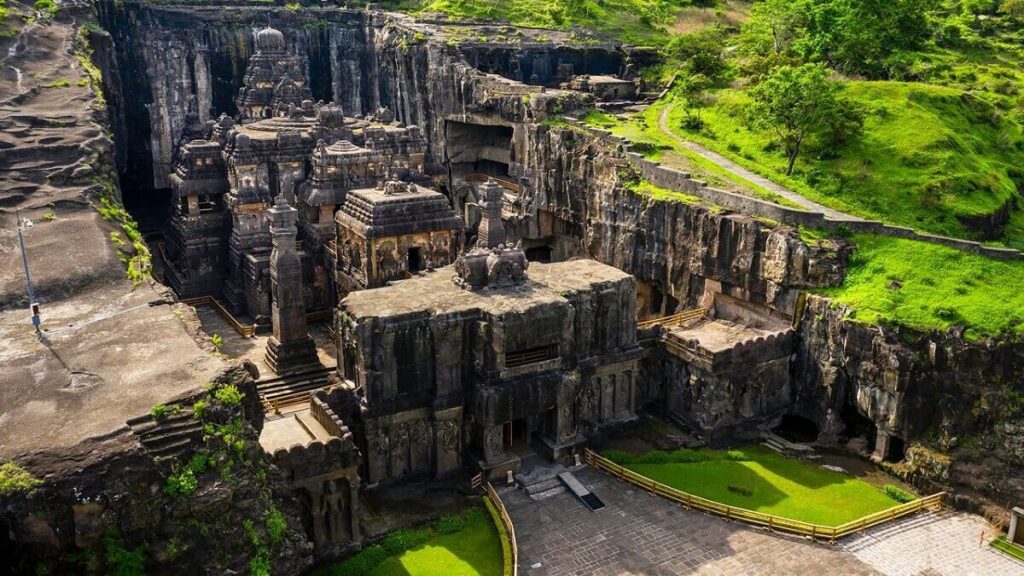
History of Ellora Caves in India
Timeline and Dynastic Patronage
The construction of the Ellora Caves in India spanned several centuries, beginning in the 6th century CE and continuing until the 10th century CE. The caves were built under the patronage of various dynasties:
- Chalukyas initiated early Buddhist caves.
- Rashtrakutas commissioned the grand Hindu caves, including the iconic Kailasa Temple.
- Yadavas supported the creation of Jain caves in the later phase.
This multi-religious patronage reflects the pluralistic ethos of ancient India, where rulers supported diverse spiritual traditions.
Religious Coexistence
Ellora is one of the few places in the world where Buddhist viharas, Hindu temples, and Jain shrines exist in close proximity. This architectural arrangement was not accidental — it was a deliberate expression of religious harmony and mutual respect.
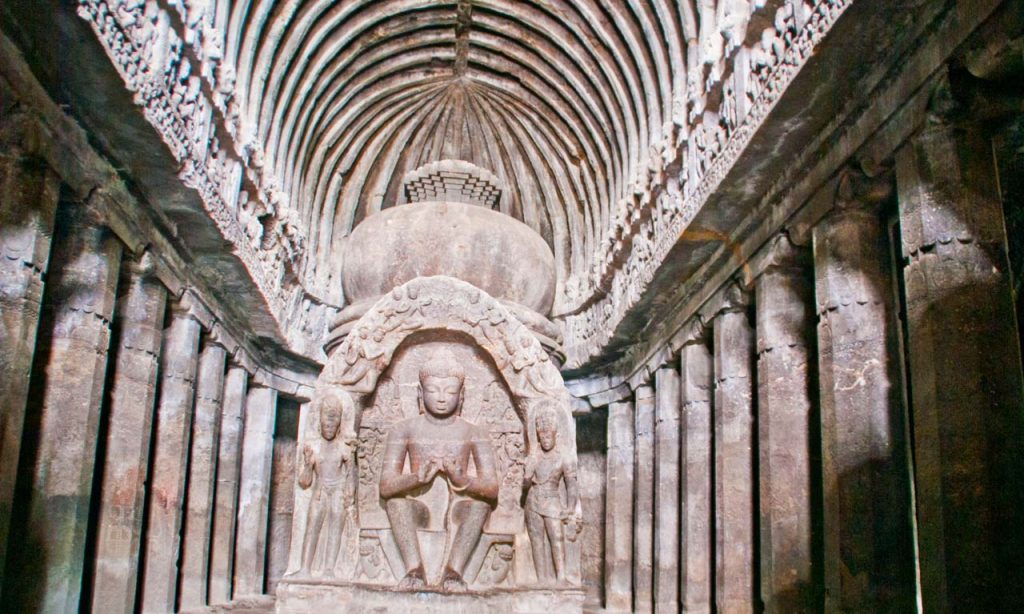
Architecture of Ellora Caves in India
Rock-Cut Techniques and Materials
The Ellora Caves in India were excavated from solid basalt rock using chisels, hammers, and rudimentary tools. The artisans carved from top to bottom a technique known as vertical excavation — to ensure structural integrity.
Division of Caves
The site comprises 34 caves, divided as follows:
- 12 Buddhist Caves (Caves 1–12): Featuring monasteries, prayer halls, and stupas. Cave 10 (Vishvakarma Cave) is a standout with its cathedral-like chaitya hall.
- 17 Hindu Caves (Caves 13–29): Richly adorned with sculptures of deities, mythological scenes, and temple architecture. Cave 16 (Kailasa Temple) is the crown jewel.
- 5 Jain Caves (Caves 30–34): Smaller but intricately detailed, showcasing Jain Tirthankaras and celestial motifs.
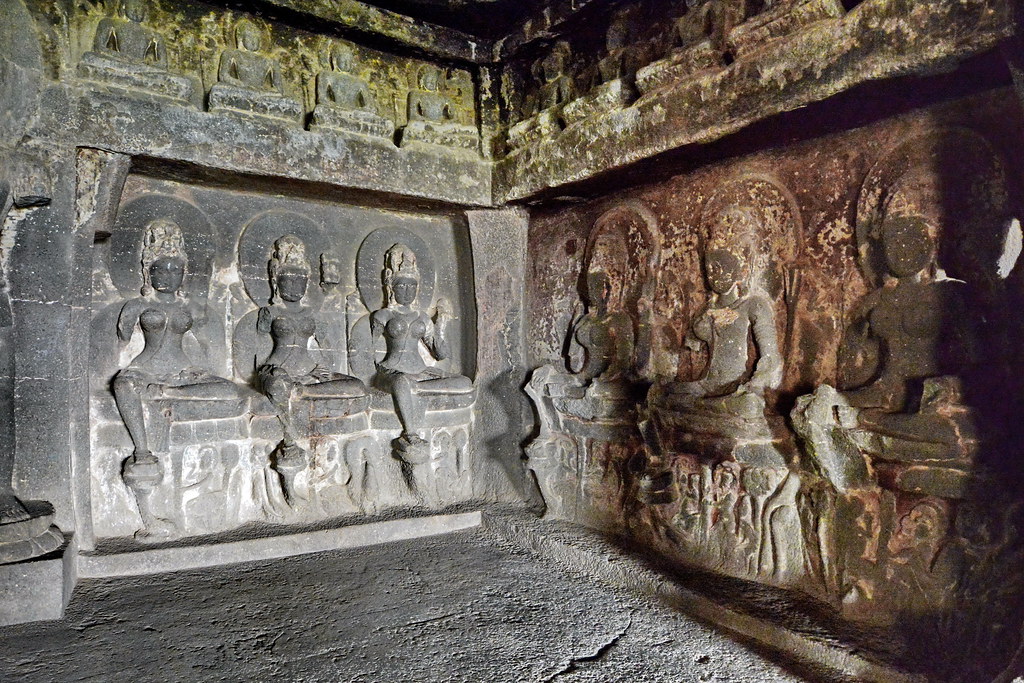
Famous Caves and Highlights
Kailasa Temple (Cave 16)
The Kailasa Temple is the largest monolithic rock excavation in the world. Carved from a single rock, it represents Mount Kailash the abode of Lord Shiva. Highlights include:
- Ravana lifting Kailash: A dynamic sculpture showing Ravana shaking the mountain.
- Nandi Mandapa: A pavilion housing Shiva’s bull.
- Bridge connecting mandapa to sanctum: Symbolizing spiritual transition.
Buddhist Highlights
- Cave 10 (Vishvakarma Cave): A chaitya hall with a seated Buddha and ribbed ceiling resembling wooden architecture.
- Cave 5: A massive hall with benches, possibly used for teaching or communal dining.
Jain Highlights
- Cave 32 (Indra Sabha): Features a shrine with Mahavira, Yakshas, and celestial dancers.
- Cave 33: Known for its intricate lotus carvings and meditative ambiance.
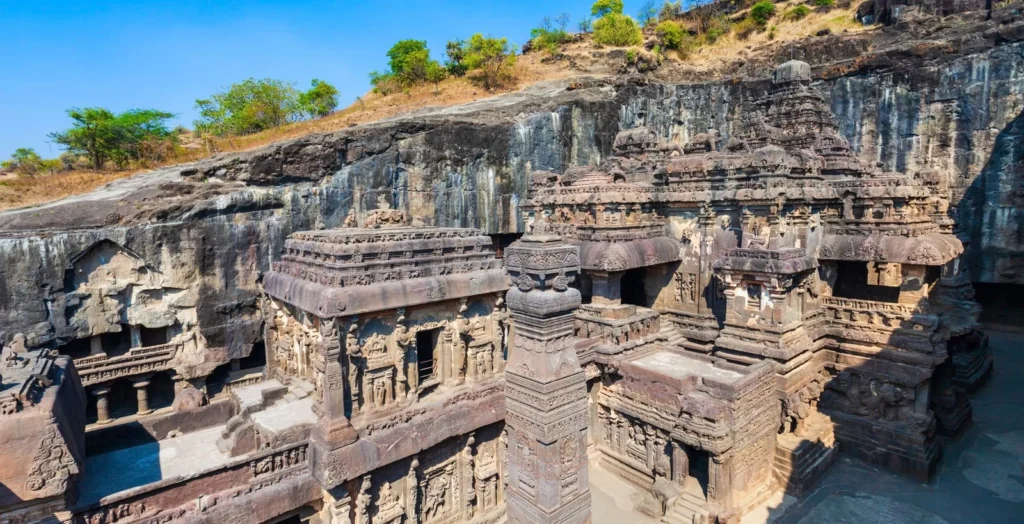
Sculptures, Carvings & Iconography
The Ellora Caves in India are a treasure trove of iconography:
- Hindu Scenes:
- Shiva as Nataraja (Lord of Dance)
- Dashavatara (Ten Avatars of Vishnu)
- Durga slaying Mahishasura
- Buddhist Imagery:
- Seated Buddha in meditation
- Bodhisattvas with compassionate expressions
- Jain Motifs:
- Tirthankaras in lotus posture
- Yakshas and celestial beings
The carvings are not just decorative they are visual scriptures conveying philosophical and spiritual teachings.
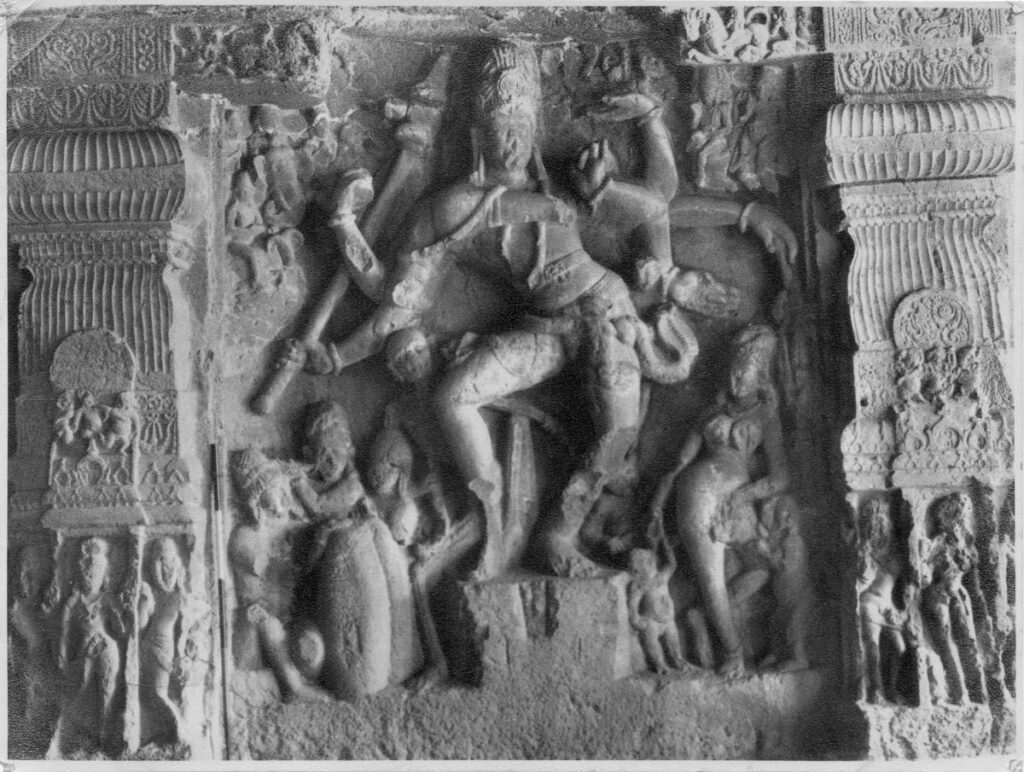
UNESCO World Heritage Status
The Ellora Caves in India were inscribed as a UNESCO World Heritage Site in 1983 under the following criteria:
- Criterion (i): Masterpiece of human creative genius.
- Criterion (iii): Exceptional testimony to cultural tradition.
- Criterion (vi): Association with spiritual ideas and beliefs.
UNESCO recognizes Ellora as a symbol of religious tolerance, artistic excellence, and technological achievement
Tourism Guide: Visiting Ellora Caves in India
How to Reach
- By Air: Nearest airport is Cha Sambhaji Nagar (29 km).
- By Rail: Cha Sambhaji Nagar Railway Station is well-connected to Mumbai, Pune, and Hyderabad.
- By Road: NH-211 and state highways offer smooth connectivity. Buses and taxis are readily available.
Entry Fees & Timings
- ₹40 for Indian citizens
- ₹600 for foreign nationals
- ₹25 for video camera
- Open from 6:00 AM to 6:00 PM (Closed on Tuesdays)
Facilities
- Parking, restrooms, drinking water, and guides available on-site.
Best Time to Visit Ellora Caves in India
- October to March is ideal for pleasant weather and clear skies.
- Avoid June to September due to monsoon rains and slippery terrain.
Photography & Travel Tips
- Flash photography is prohibited inside caves.
- Tripods require special permission.
- Early morning visits offer best lighting and fewer crowds.
- Wear comfortable shoes and carry water.
Nearby Attractions
- Ajanta Caves – Buddhist murals and monastic caves.
- Daulatabad Fort – Medieval hill fort with panoramic views.
- Grishneshwar Jyotirlinga – One of the 12 sacred Shiva shrines.
- Bibi Ka Maqbara – Mughal-era tomb resembling the Taj Mahal.
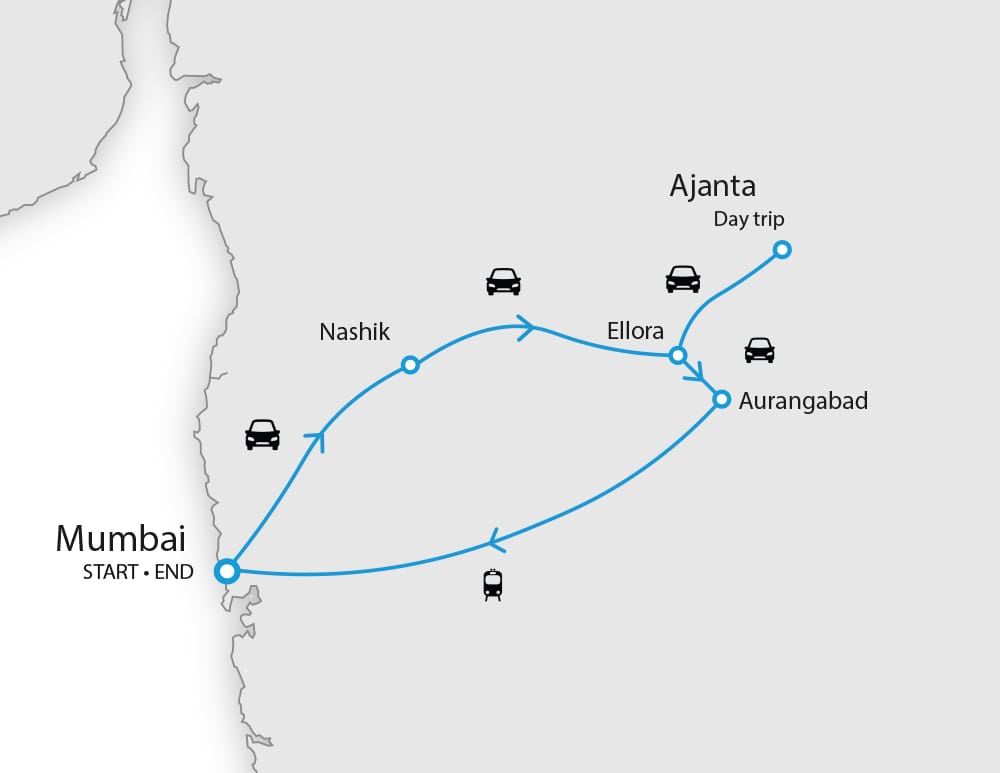
Conservation Efforts
The Archaeological Survey of India (ASI) and UNESCO oversee preservation. Key initiatives include:
- Climate control and drainage systems.
- Restricted access to sensitive areas.
- Digital documentation and 3D mapping.
Challenges include:
- Weathering of basalt rock.
- Tourist footfall and pollution.
- Funding and skilled restoration personnel.
Modern Significance
Today, the Ellora Caves in India are:
- A major tourist attraction in Maharashtra.
- A source of inspiration for artists and architects.
- A spiritual retreat for pilgrims and seekers.
- A subject of global academic research.
Ellora continues to shape India’s cultural identity and global heritage narrative.
FAQs – Ellora Caves in India
Q1: What is special about Ellora Caves in India?
A: The Ellora Caves in India are unique for showcasing Hindu, Buddhist, and Jain monuments side by side, carved directly into basalt cliffs. This architectural marvel reflects religious harmony and artistic excellence from the 6th to 10th century CE.
Q2: How many caves are there in Ellora Caves in India?
A: There are 34 caves at Ellora 12 Buddhist, 17 Hindu, and 5 Jain. Each group features distinct architectural styles, sculptures, and spiritual themes.
Q3: Is Kailasa Temple part of Ellora Caves in India?
A: Yes, Kailasa Temple (Cave 16) is the most famous monument within Ellora Caves in India. It is the largest monolithic rock-cut temple in the world, dedicated to Lord Shiva and carved from a single rock.
Q4: What is the best time to visit Ellora Caves in India?
A: The best time to visit Ellora Caves in India is from October to March, when the weather is cool and dry. Avoid the monsoon season due to slippery terrain and reduced visibility.
Q5: How are Ellora Caves in India different from Ajanta Caves?
A: Ellora Caves in India feature Hindu, Buddhist, and Jain monuments, while Ajanta Caves are exclusively Buddhist. Ellora emphasizes rock-cut architecture and sculpture, whereas Ajanta is renowned for its ancient murals and frescoes.
Q6: Are Ellora Caves in India open every day?
A: Ellora Caves in India are open daily from 6:00 AM to 6:00 PM, except on Tuesdays when the site is closed for maintenance.
Q7: Is photography allowed inside Ellora Caves in India?
A: Yes, photography is allowed in most areas of Ellora Caves in India. However, flash photography is prohibited inside the caves to protect the artwork, and tripods require special permission.
Recommended External Links
- Ellora Caves – UNESCO World Heritage Centre
Official UNESCO listing with historical context, maps, and documentation - Ellora Caves – Archaeological Survey of India
Government-maintained page with geological details, virtual tour, and conservation notes - Ellora Caves – Wikipedia Comprehensive overview including cave numbers, dynastic history, and architectural features

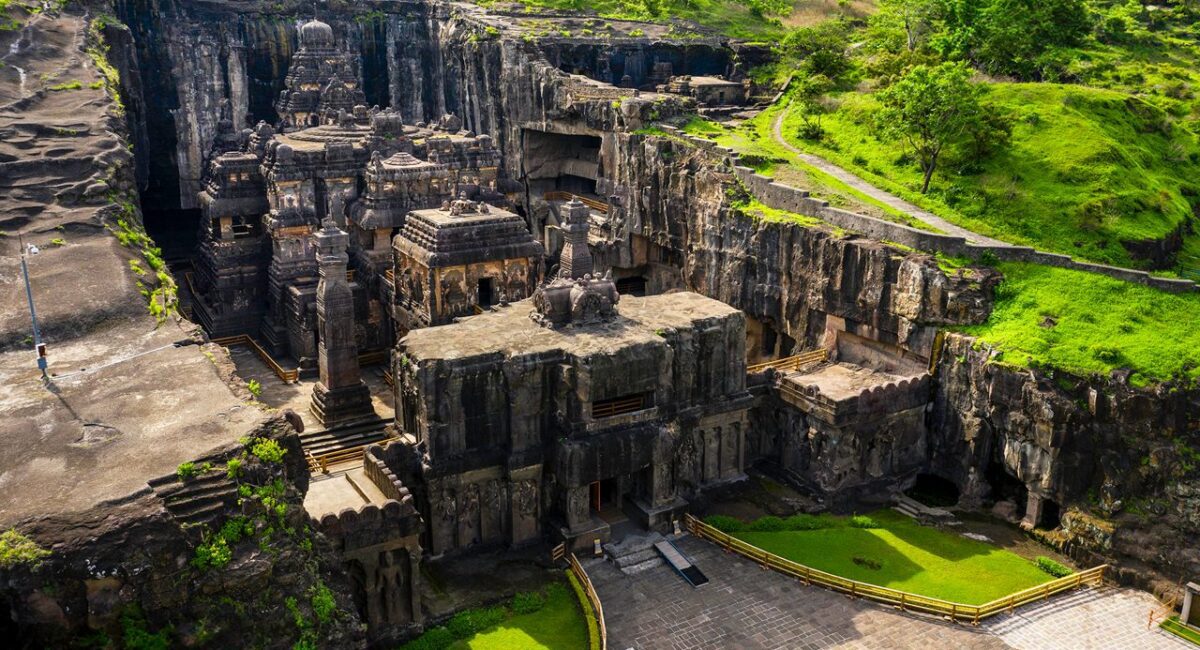
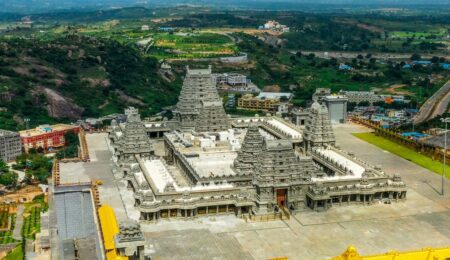
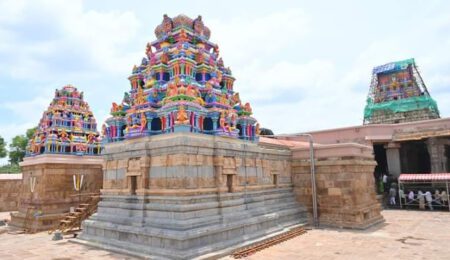
Leave a Comment